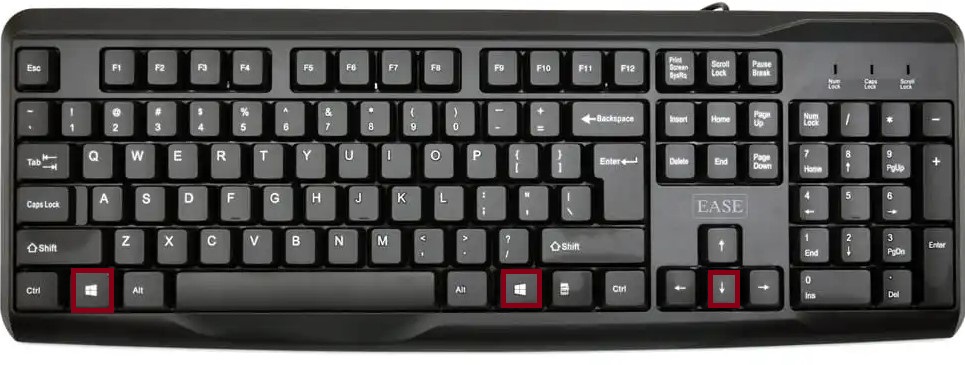The Windows+Down Arrow shortcut is a built-in Windows key combination used primarily for minimizing or restoring the current window. It plays an essential role in Windows’ Snap Assist and window management features, especially in multitasking environments.
This article explores how Windows + Down Arrow behaves across Microsoft applications, other software, how to troubleshoot when it’s not working, and the Mac equivalent. Let’s dive in.
Table of Contents
🔹 What Does Windows+Down Arrow Do?
The behavior of Windows + Down Arrow varies depending on the current window state:
- If the window is maximized:
➜ Pressing the shortcut will restore it to its previous (resizable) size. - If the window is restored (not maximized):
➜ Pressing the shortcut will minimize the window to the taskbar. - If the window is snapped (e.g., to the left/right):
➜ It will move to a corner position, and pressing it again will minimize it.

This makes it ideal for moving windows out of view quickly or toggling between maximized and minimized states without a mouse.
🔸 Use of Windows + Down Arrow in Microsoft Applications
📝 Microsoft Word, Excel, and PowerPoint
- Allows users to instantly minimize or restore their documents without clicking the minimize button.
- Useful for hiding sensitive documents quickly or jumping between multiple files.
📧 Microsoft Outlook
- Easily toggle between reading and minimizing your inbox or calendar.
- Especially helpful when juggling between Outlook and browsers or Excel.
💬 Microsoft Teams and OneNote
- Minimize Teams during meetings when multitasking with other apps.
- In OneNote, return to desktop or a smaller view quickly without interfering with your layout.
📊 Power BI, Access
- Quickly restore dashboards or minimize data models while cross-referencing with Excel or reports.
🔹 Use in Other Applications
This shortcut is effective and widely supported across third-party apps and tools.
🌐 Web Browsers (Chrome, Edge, Firefox)
- Minimize your browser window quickly when switching to a more secure or private application.
- Restore it to a resizable size when moving tabs or dragging windows.
💻 Development Tools (VS Code, Visual Studio)
- Temporarily minimize your IDE to check reference material or task lists.
- Restore from the taskbar and resume without using the mouse.
🖼 Adobe Creative Suite (Photoshop, Premiere Pro)
- Collapse large, complex workspaces to the background while previewing output elsewhere.
- Helps free screen real estate in dual-screen setups.
📁 File Explorer and Utilities
- Minimize or restore File Explorer instantly while multitasking or dragging/dropping files.
⚠️ FAQs
Sometimes, Windows + Down Arrow may not behave as expected. Here are common issues and how to fix them:
1. Application Restrictions
Some full-screen apps (e.g., games or virtual machines) may block the shortcut or override it.
2. Already Minimized
If the window is already minimized, the shortcut won’t reverse the action (you’ll need to click it from the taskbar).
3. Group Policy Restrictions
In enterprise environments, IT admins may disable certain Snap or window management features.
4. Conflicting Software
Third-party tools (e.g., PowerToys, display managers) may override or intercept the shortcut.
Fixes:
- Ensure your version of Windows supports Snap (Windows 10/11).
- Enable Snap Assist under Settings > System > Multitasking.
- Close background tools that override system shortcuts.
🍎 Mac Equivalent of Windows + Down Arrow
macOS doesn’t offer a direct equivalent of Windows+Down Arrow. However, similar window control features can be achieved using:
Built-in Methods:
- Command + M: Minimizes the active window to the Dock.
- Command + H: Hides the active application completely.
With Apps:
Using Rectangle or Magnet (popular Mac window managers), you can assign keyboard shortcuts to perform minimize or restore functions similar to Windows + Down Arrow.
✅ Summary Table
| Shortcut | Action Performed |
|---|---|
| Windows + Down Arrow | Restore (if maximized) or Minimize active window |
| Windows + Up Arrow | Maximize window |
| Windows + Left Arrow | Snap window to the left |
| Windows + Right Arrow | Snap window to the right |
| Mac Equivalent | Cmd + M or Cmd + H (not identical) |
📝 Final Thoughts
The Windows + Down Arrow shortcut is a valuable part of Windows’ built-in window management toolkit. From minimizing distractions to toggling window states quickly, it boosts productivity by removing the need for manual resizing or mouse clicks.
Whether you’re working in Microsoft Word, switching between browsers, or coding in Visual Studio, this shortcut helps streamline your workflow. Pair it with Windows + Up, Left, and Right Arrows for complete keyboard-based window control.